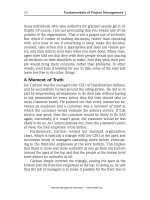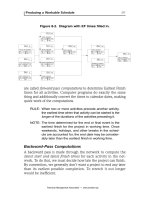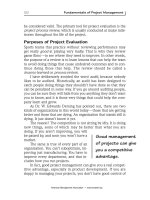IT project management 3rd by THompson chap01 7
Bạn đang xem bản rút gọn của tài liệu. Xem và tải ngay bản đầy đủ của tài liệu tại đây (374.46 KB, 31 trang )
Chapter 1:
Introduction to Project
Management
Learning Objectives
• Understand the growing need for better
project management, especially for
information technology projects
• Explain what a project is and provide
examples of information technology projects
• Describe what project management is and
discuss key elements of the project
management framework
Learning Objectives
• Discuss how project management relates to
other disciplines
• Understand the history of project
management
• Describe the project management
profession, including recent trends in
project management research, certification,
and software products
Project Management Statistics
• The U.S. spends $2.3 trillion on projects
every year, an amount equal to one-quarter
of the nation’s gross domestic product.
• The world as a whole spends nearly $10
trillion of its $40.7 trillion gross product on
projects of all kinds.
• More than sixteen million people regard
project management as their profession; on
average, a project manager earns more
than $82,000 per year.*
*PMI, The PMI Project Management Fact Book, Second Edition, 2001
More Information
on Project Management
• More than half a million new information
technology (IT) application development
projects were initiated during 2001, up from
300,000 in 2000.*
• Famous business authors and consultants
are stressing the importance of project
management. As Tom Peters writes in his
book, Reinventing Work: the Project 50, “To
win today you must master the art of the
project!”
*The Standish Group, “CHAOS 2001: A Recipe for Success”
Motivation for Studying Information
Technology (IT) Project Management
• IT projects have a terrible track record
– A 1995 Standish Group study (CHAOS) found
that only 16.2% of IT projects were successful
and over 31% were canceled before completion,
costing over $81 B in the U.S. alone
• The need for IT projects keeps increasing
– In 2000, there were 300,000 new IT projects
– In 2001, over 500,000 new IT projects were
started
Advantages of Using Formal
Project Management
• Better control of financial, physical, and
human resources
• Improved customer relations
• Shorter development times
• Lower costs
• Higher quality and increased reliability
• Higher profit margins
• Improved productivity
• Better internal coordination
• Higher worker morale
What Is a Project?
• A project is “a temporary endeavor
undertaken to accomplish a unique product or
service” (PMBOK® Guide 2000, p. 4)
• Attributes of projects
– unique purpose
– temporary
– require resources, often from various areas
– should have a primary sponsor and/or customer
– involve uncertainty
Samples of IT Projects
• Northwest Airlines developed a new reservation
system called ResNet (see case study on
companion Web site at
www.course.com/mis/schwalbe)
• Many organizations upgrade hardware,
software, and networks via projects
• Organizations develop new software or enhance
existing systems to perform many business
functions
• Note: “IT projects” refers to projects involving
hardware, software, and networks
The Triple Constraint
• Every project is constrained in different ways by
its
– Scope goals: What is the project trying to
accomplish?
– Time goals: How long should it take to
complete?
– Cost goals: What should it cost?
• It is the project manager’s duty to balance
these three often competing goals
Figure 1-1. The Triple Constraint
of Project Management
The 2001 Standish Group Report Showed
Decided Improvement in Project Success
• Time overruns significantly decreased to
163% compared to 222%
• Cost overruns were down to 145% compared
to 189%
• Required features and functions were up to
67% compared to 61%
• 78,000 U.S. projects were successful
compared to 28,000
• 28% of IT projects succeeded compared to
16%
Why the Improvements?
"The reasons for the increase in successful
projects vary. First, the average cost of a
project has been more than cut in half. Better
tools have been created to monitor and
control progress and better skilled project
managers with better management
processes are being used. The fact that
there are processes is significant in itself.“*
*The Standish Group, "CHAOS 2001: A Recipe for
Success" (2001)
What is Project Management?
Project management is “the application of
knowledge, skills, tools, and techniques to
project activities in order to meet project
requirements” (PMI*, Project Management
Body of Knowledge (PMBOK® Guide), 2000,
p. 6)
*The Project Management Institute (PMI) is an international
professional society. Their web site is www.pmi.org.
Figure 1-2. Project Management
Framework
Project Stakeholders
• Stakeholders are the people involved in or
affected by project activities
• Stakeholders include
– the project sponsor and project team
– support staff
– customers
– users
– suppliers
– opponents to the project
9 Project Management
Knowledge Areas
• Knowledge areas describe the key competencies
that project managers must develop
– 4 core knowledge areas lead to specific project
objectives (scope, time, cost, and quality)
– 4 facilitating knowledge areas are the means through
which the project objectives are achieved (human
resources, communication, risk, and procurement
management)
– 1 knowledge area (project integration management)
affects and is affected by all of the other knowledge
areas
Project Management Tools and
Techniques
• Project management tools and techniques assist
project managers and their teams in various
aspects of project management
• Some specific ones include
– Project Charter, scope statement, and WBS (scope)
– Gantt charts, network diagrams, critical path
analysis, critical chain scheduling (time)
– Cost estimates and earned value management (cost)
– See Table 1-1 on p. 11 for many more
How Project Management Relates
to Other Disciplines
• Much of the knowledge needed to manage
projects is unique to the discipline of project
management
• Project mangers must also have knowledge
and experience in
– general management
– the application area of the project
History of Project Management
• Some people argue that building the
Egyptian pyramids was a project, as was
building the Great Wall of China
• Most people consider the Manhattan Project
to be the first project to use “modern”
project management
• This three-year, $2 billion (in 1946 dollars)
project had a separate project manager and
a technical manager
Sample Gantt Chart
The WBS is on the left, and each task’s start and finish date
are shown on the right using a calendar timescale. Early Gantt
Charts, first used in 1917, were drawn by hand.
Sample Network Diagram
Each box is a project task from the WBS. Arrows show dependencies
between tasks. The bolded tasks are on the critical path. If any tasks on the
critical path take longer than planned, the whole project will slip
unless something is done. Network diagrams were first used in 1958 on the
Navy Polaris project, before project management software was available.
Sample Enterprise Project
Management Tool
In recent years, organizations have been taking advantage of software
to help manage their projects throughout the enterprise.
The Project Management
Profession
• The job of IT Project Manager is in the list
of the top ten most in demand IT skills
• Professional societies like the Project
Management Institute (PMI) have grown
tremendously
• Project management research and
certification programs continue to grow
Table 1-2. Top Ten Most in
Demand IT Skills
Rank
IT Skill/Job
Average Annual Salary
1
SQL Database Analyst
$80,664
2
Oracle Database Analyst
$87,144
3
C/C++ Programmer
$95,829
4
Visual Basic Programmer
$76,903
5
E-commerce/Java Developer
$89,163
6
Windows NT/2000 Expert
$80,639
7
Windows/Java Developert
$93,785
8
Security Architect
$86,881
9
Project Manager
$95,719
10
Network Engineer
$82,906
Paul Ziv, “The Top 10 IT Skills in Demand,” Global Knowledge Webcast
(www.globalknowledge.com) (11/20/2002).









